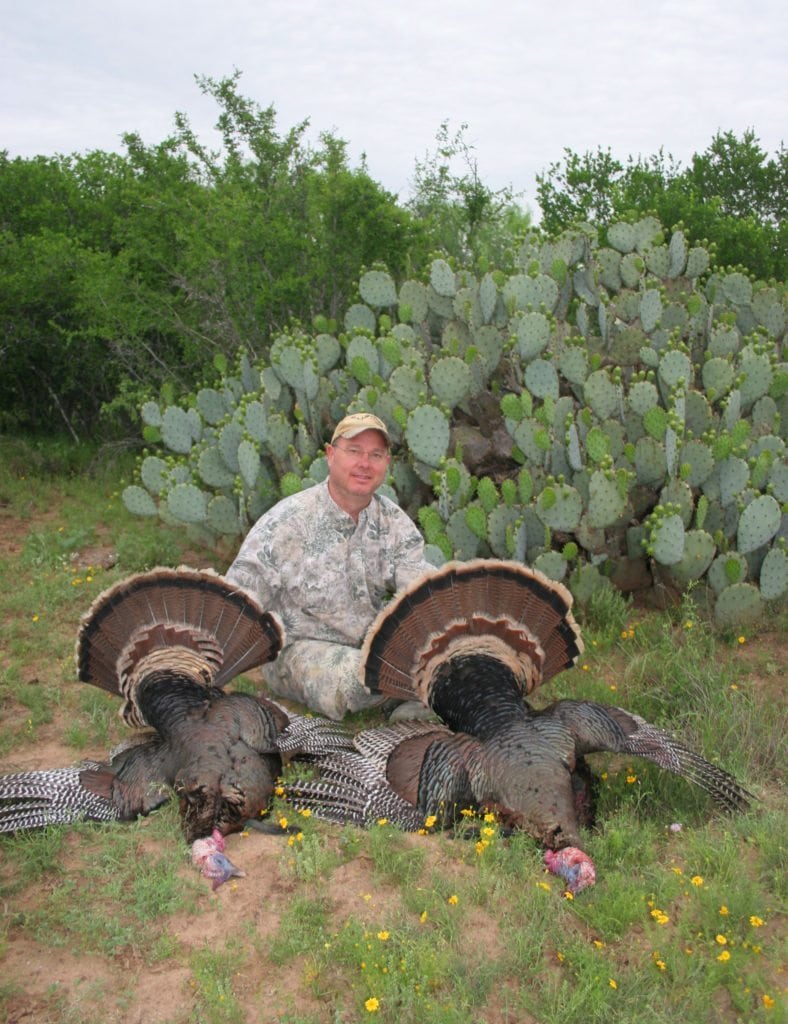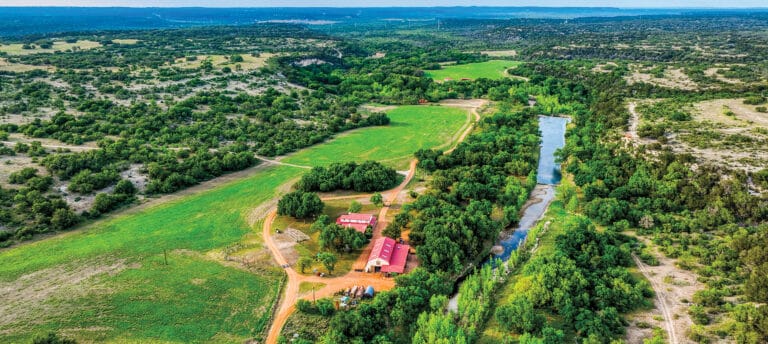We were set up against the base of a couple of big bull mesquite trees, overlooking dry creek wash that was lined in mature hackberries which provided a perennial roosting site for turkeys. As the dark of night was giving way to the gray shades of morning, an ominous Texas spring-time storm was easing our way. We had yet to hear the first sign of confirmation that the roost was even occupied, which already had me thinking about a quick move to a Plan B, when the distant thunder of the storm let out a loud rumble, followed by a resounding chorus of some dozen gobbling turkeys. Twenty minutes later, five long-beards came strutting into our view and as the third bird cleared the agarita 27 paces away, my client folded that big old gobbler with a load of #6 heavy shot. As we admired the beautiful bird, while still enjoying the distant sounds of the storm and the gobblers, my client and business mentor Dick Laros extolled, “I never grow tired of hunting turkeys during the spring. In fact, out of all the game that I’ve hunted over the far reaches of North America and on several other continents, my favorite hunt is a toss-up between Cape buffalo on the mopane flats of the Zambezi Valley and calling gobblers in the cactus-laden country of West Texas.”
The bird
In Texas, and elsewhere, the history of the wild turkey is one of the great wildlife conservation success stories. Though their numbers were plentiful during the first half of the 1800s, by the early 1900’s these birds were on the brink of extirpation from most of their historic ranges, principally because of unregulated killing of the birds, along with the loss of critical habitat in certain locales. But, in the words of Aldo Leopold, “Game can be restored by the creative use of the same tools which have heretofore destroyed it,” and that’s certainly the case with the success of wild turkey restoration. Through a cooperative effort between hunters, private landowners, and state wildlife agencies, restoration programs were implemented using translocation of turkeys, sound regulations, and habitat management practices as the platforms for an amazing comeback of our country’s largest gamebird. Restoration funds were largely generated through hunting-related sources including hunting license fees, Pittman-Robertson funds (excise tax on sporting arms and ammo), and through sportsman’s groups.
Today, Texas is home to more wild turkeys than any state in the country, supporting an estimated 600,000+ birds, located in all but about 30 of Texas’ 254 counties. The Rio Grande strain is by far the most numerous and widely distributed of the three strains found in Texas, but there are a modest number of Eastern birds in some East Texas counties, along with a very limited number of Merriam’s birds in a small area of the Tran-Pecos.
The hunt
It’s been said that if turkeys had a decent sense of smell, they would be darn near impossible to successfully hunt. These birds have uncanny eyesight and hearing, which makes for a great hunting challenge, especially if you are hunting them in the traditional style of calling them in to within reasonable shotgun or archery range. The general spring turkey season for Rio Grande birds is 6 weeks long, with the south zone beginning on the third Saturday of March, two weeks earlier than the start of the north zone. The Eastern spring gobbler season is 4 weeks in length, beginning on the third Saturday of April. Some of the more popular hunting counties for Rios in the North Zone include Tom Green, Sutton, Schleicher, Concho, and McCulloch, while some of the more noted South Texas counties include Kleberg, Willacy, Brooks, Uvalde, and Zavalla. However, there are many great turkey hunting locales that are found in a host of other counties that are not mentioned, here.
Equipment requirements for hunting these birds during the spring include camo from head to toe, standard turkey calls, bug spray, and a gun or bow of choice. Turkey hunting purists generally frown on the use of rifles. Personally, I prefer a 12 gauge shotgun with #6 shot, and it’s my opinion that a 20-gauge can be a bit too light for these big birds. It is important to pattern your gun with the load of choice and to aim accordingly, taking into consideration the pellet density pattern. The vital kill zone of a turkey is the head and neck area if using a shotgun.
Proper techniques for hunting these amazing birds is best accrued through some mentoring from a seasoned turkey hunter to establish some basics, and then fine-tuning those skills through the tribulations of trial and error. Like hunting elk during the bugle, it’s the interaction between the hunter and the quarry that makes spring turkey hunting so exciting and unique. When combined with the pleasantries of a nice Texas spring, this provides a hunting experience that’s hard to beat.
The outfitter
Wildlife Systems, Inc. (WSI) is a hunting and wildlife management firm that was started in 1987. In addition to offering hunts for a wide variety of other game and exotics, WSI is one of the premier turkey hunting outfitters in Texas. This company conducts spring turkey hunts on over 100,000 acres in both the north and south zones, encompassing many different properties. These hunts are typically set up as a 2.5 – 3 day hunt, including meals, lodging, guide, and game care. Guiding can be as basic as the guide dropping the hunters out at prime locations and allowing the hunter to do their own calling, or the guide can stay with the hunter providing the calling services for the client. Lodging varies from ranch style cabins to luxurious facilities. WSI also offers a limited number of unassisted turkey hunts where hunters do their own cooking and guiding, and lodging may or may not be included. Most packages that are provided by WSI include a 2 bird limit, but one unique package offers a combination of one turkey, one javelina, and one hog.

For additional information on hunting with WSI, check out their website at www.wildlifesystems.com or call (325)655-0877.




